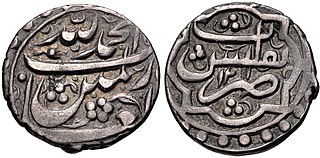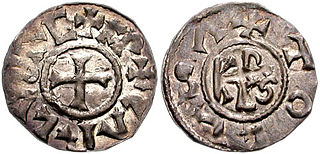
The denarius was the standard Roman silver coin from its introduction in the Second Punic War c. 211 BC to the reign of Gordian III, when it was gradually replaced by the antoninianus. It continued to be minted in very small quantities, likely for ceremonial purposes, until and through the Tetrarchy (293–313).

The shilling is a historical coin, and the name of a unit of modern currencies formerly used in the United Kingdom, Australia, New Zealand, other British Commonwealth countries and Ireland, where they were generally equivalent to 12 pence or one-twentieth of a pound before being phased out during the 1960s and 1970s.

The dinar is the name of the principal currency unit in several countries near the Mediterranean Sea, with a more widespread historical use. The English word "dinar" is the transliteration of the Arabic دينار (dīnār), which was borrowed via the Syriac dīnarā, itself from the Latin dēnārius.
Byzantine currency, money used in the Eastern Roman Empire after the fall of the West, consisted of mainly two types of coins: the gold solidus and a variety of clearly valued bronze coins. By the end of the empire the currency was issued only in silver stavrata and minor copper coins with no gold issue.

The solidus or nomisma was a highly pure gold coin issued in the Late Roman Empire and Byzantine Empire. The early 4th century saw the solidus introduced in mintage as a successor to the aureus, which was permanently replaced thereafter by the new coin, whose weight of about 4.5 grams remained relatively constant for seven centuries. In the Byzantine Empire, the solidus, or nomisma, remained a highly pure gold coin until the 11th century, when several Byzantine emperors began to strike the coin with less and less gold. The nomisma was finally abolished by Alexius I in 1092, who replaced it with the hyperpyron, which also came to be known as a "bezant". The Byzantine solidus also inspired the originally slightly less pure dinar issued by the Muslim Caliphate. In Western Europe, the solidus was the main gold coin of commerce from late Roman times to Pepin the Short's currency reform in the 750s, which introduced the silver-based pound/shilling/penny system.

The aureus was a gold coin of ancient Rome originally valued at 25 pure silver denarii. The aureus was regularly issued from the 1st century BC to the beginning of the 4th century AD, when it was replaced by the solidus. The aureus was about the same size as the denarius, but heavier due to the higher density of gold.

The dirham, dirhem or dirhm is a unit of currency and of mass. It is the name of the currencies of Morocco and the United Arab Emirates, and is the name of a currency subdivision in Jordan, Libya, Qatar and Tajikistan. It was historically a silver coin.
The fineness of a precious metal object represents the weight of fine metal therein, in proportion to the total weight which includes alloying base metals and any impurities. Alloy metals are added to increase hardness and durability of coins and jewelry, alter colors, decrease the cost per weight, or avoid the cost of high-purity refinement. For example, copper is added to the precious metal silver to make a more durable alloy for use in coins, housewares and jewelry. Coin silver, which was used for making silver coins in the past, contains 90% silver and 10% copper, by mass. Sterling silver contains 92.5% silver and 7.5% of other metals, usually copper, by mass.
The Murabitun World Movement is an Islamic movement founded by Abdalqadir as-Sufi, with communities in several countries. Its heartland is Spain. The number of its followers may amount, according to one estimate, to around 10,000.
In Sharia niṣāb (نِصاب) is the minimum amount of wealth that a Muslim must have before being obliged to give zakat. Zakat is determined based on the amount of wealth acquired; the greater one's assets, the greater the zakat value. Unlike taxable income in secular states, niṣāb is not subject to special exemptions.
The maravedí or maravedi, , was the name of various Iberian coins of gold and then silver between the 11th and 14th centuries and the name of different Iberian accounting units between the 11th and 19th centuries.

Abazi was a Georgian silver coin, deriving its name and existence from the Iranian abbasi, which was in use from the early 17th century into the early 19th.
The Kelantanese dinar is a currency issued by the Government of the Malaysian state of Kelantan, which purportedly is in conformance with the concept of the Islamic gold dinar. The Kelantanese dinar is available in the form of coins of several denominations. These coins were first struck in 2006 by Mariwasa Kraftangan of Kuala Kangsar, Perak, a local producer of souvenirs and replicas of objects of art and culture, and launched by the state of Kelantan on 20 September 2006. The Government of Kelantan had suggested that the coins had the status of legal tender, and the state-issued dinar sold out quickly, with many buyers seeing the gold dinar as a better choice than fiat money.

The gold dinar is an Islamic medieval gold coin first issued in AH 77 (696–697 CE) by Caliph Abd al-Malik ibn Marwan. The weight of the dinar is 1 mithqal.

Mithqāl is a unit of mass equal to 4.25 grams (0.137 ozt) which is mostly used for measuring precious metals, such as gold, and other commodities, like saffron.
The Rhenish gulden or Rhenish guilder was a gold, standard currency coin of the Rhineland in the 14th and 15th centuries. They weighed between 3.4 and 3.8 grams (0.12–0.13 oz).
The history of money in Kievan Rus' is divided into two main phases:

The "Pahlavi Coins" were the official gold coins of Iran from 1926 to 1979, and the term "Pahlavi" is the currency of these coins. These coins replaced the Qajar Toman gold coins when Reza Shah Pahlavi came to power in 1925 and the monetary system changed in 1926. In 1979 and coincidence with Revolution in Iran the name of these coins changed to "Bahar Azadi" coins.

The Islamic State dinar, also simply the gold dinar, is the de jure currency of the Islamic State, a terrorist organization and former proto-state from 2014 to 2019. It is subdivided into dirhams and fulûs, and it has its origins in the historical gold dinar. In 2016, one gold dinar was exchanged for US$190 or £91 sterling.

The Carolingian monetary system, also called the Carolingian coinage system or just the Carolingian system, was a currency structure introduced by Charlemagne in the late 8th century as part of a major reform, the effects of which subsequently dominated much of Europe, including Britain, for centuries. It is characterised by having three denominations with values in the ratio 240:12:1, the units of which went under different names in the different languages, but which corresponded to the Latin terms libra (pound), solidus (shilling) and denarius (penny), respectively.














